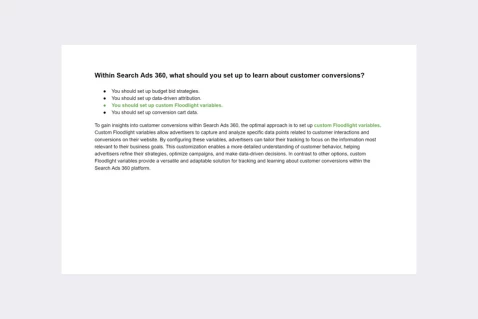Your customer is aiming to not only drive conversions but also track how those conversions drive users to enroll in their weekly newsletter distribution list. When setting up their data-driven attribution model in Search Ads 360, what else should you set up?
Multichannel groupings
Custom channel groupings
Automated channel groupings
Keyword groupings
Certification program: 👉 Google Search Ads 360 certification exam
Explanation: When setting up a data-driven attribution model in Search Ads 360 with the goal of not only driving conversions but also tracking how those conversions drive users to enroll in a weekly newsletter, it is essential to “set up Custom channel groupings.” Custom channel groupings allow advertisers to categorize and analyze traffic sources based on their specific business objectives. By creating custom channels that align with the newsletter enrollment goal, advertisers can gain insights into the impact of different channels on driving both conversions and newsletter sign-ups. Unlike Multichannel groupings, Automated channel groupings, or Keyword groupings, Custom channel groupings provide the flexibility needed to tailor the attribution model to the unique objectives of the customer’s campaign in Search Ads 360.
Passing exams is not a workout. Multiple attempts won’t make you stronger.



- All possible Search Ads 360 certification exam questions with answers, and explanations.
- Real certification exam questions
- Detailed answer explanations.
- Reflects exactly the latest real exam questions.
- Free lifetime updates.
When setting up a data-driven attribution model in Search Ads 360 to track conversions and understand their impact on newsletter sign-ups, there are several additional steps that the customer should consider implementing to ensure comprehensive tracking and analysis. While the data-driven attribution model provides valuable insights into the effectiveness of advertising channels in driving conversions, integrating with other tools and platforms can enhance the customer’s ability to track user behavior and measure the impact of advertising efforts on newsletter enrollment.
One essential component to set up in conjunction with the data-driven attribution model is conversion tracking for newsletter sign-ups. By implementing conversion tracking tags on the website’s newsletter sign-up page, the customer can accurately track when users complete the enrollment process after interacting with their ads. This allows the customer to attribute newsletter sign-ups directly to specific advertising channels and campaigns, providing valuable insights into the contribution of each channel to newsletter enrollment.
Additionally, the customer should leverage Google Analytics in conjunction with Search Ads 360 to gain deeper insights into user behavior and engagement with the newsletter sign-up process. By linking Google Analytics with Search Ads 360 and enabling cross-platform tracking, the customer can analyze user interactions leading up to newsletter sign-ups, such as website visits, page views, and referral sources. This integration enables the customer to understand the full customer journey and identify touchpoints that influence newsletter enrollment, allowing for more informed optimization of advertising strategies.
Furthermore, implementing event tracking for specific actions related to newsletter sign-ups can provide valuable data for analysis and optimization. For example, the customer can track events such as button clicks or form submissions on the newsletter sign-up page using Google Tag Manager or custom JavaScript tags. This allows the customer to capture additional insights into user engagement with the sign-up process and identify areas for improvement to increase conversion rates.
Moreover, utilizing audience lists and remarketing campaigns can help the customer re-engage users who have shown interest in newsletter sign-ups but have not yet completed the process. By creating custom audience segments based on user interactions with the website or previous engagement with newsletter-related content, the customer can target these users with tailored ads and messaging to encourage newsletter enrollment. This approach maximizes the customer’s ability to convert interested users into newsletter subscribers and drive ongoing engagement.
In summary, when setting up a data-driven attribution model in Search Ads 360 to track conversions and measure their impact on newsletter enrollment, it’s essential to implement conversion tracking for newsletter sign-ups, integrate with Google Analytics for deeper insights, utilize event tracking to capture user interactions, and leverage audience lists for remarketing. By implementing these strategies in conjunction with the data-driven attribution model, the customer can gain comprehensive insights into the effectiveness of their advertising efforts in driving newsletter sign-ups and optimize their strategies accordingly.
Discover our best-value guides
- Special Bundle Offer Google_Ads_Roll
- Special Bundle Offer HubSpot_Exams_Roll
- Special Offer Unchained_Guru_Roll
- Special Bundle Offer Amazon_Roll
- Special Bundle Offer Google_Analytics_Roll
- Special Bundle Offer Google_SkillShop_Roll
- Special Bundle Offer Marketing_Platforms_Roll
- Special Bundle Offer Microsoft_Advertising_Roll
- Special Bundle Offer YouTube_Roll
- Special Bundle Offer Google_Android_Roll
- Ultimate PMP certification preperation guide
- Google Cloud Professional Architect Certification Exam Answers - Ultimate Guide
- Special Bundle Offer SEMrush_Roll